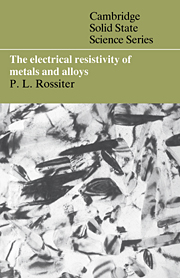Book contents
- Frontmatter
- Contents
- Preface
- 1 Basic concepts
- 2 Atomic configuration of an alloy
- 3 The structure of magnetic materials
- 4 Electrons in simple metals and alloys
- 5 Electrical resistivity of simple metals and alloys
- 6 Non-simple, non-magnetic metals and alloys
- 7 Magnetic and nearly magnetic alloys
- 8 Other phenomena
- Appendices
- References
- Index
Preface
Published online by Cambridge University Press: 07 January 2010
- Frontmatter
- Contents
- Preface
- 1 Basic concepts
- 2 Atomic configuration of an alloy
- 3 The structure of magnetic materials
- 4 Electrons in simple metals and alloys
- 5 Electrical resistivity of simple metals and alloys
- 6 Non-simple, non-magnetic metals and alloys
- 7 Magnetic and nearly magnetic alloys
- 8 Other phenomena
- Appendices
- References
- Index
Summary
The electrical resistance or resistivity of a conducting solid can be experimentally determined without much difficulty and for many years it has been used as a research tool to investigate various microstructural and physical phenomena. However, unlike conventional diffraction methods which are capable of mapping out scattered intensities in twoor three-dimensional space, an electrical resistivity measurement gives only a single value (at any fixed temperature and structural state) representing an average over all directions of conduction electron scattering. As there is no means of performing the back-transform from this single point, the analysis of resistivity data in terms of microstructure must incorporate calculations of conduction electron scattering based on some model of the structure or microstructure concerned. With the refinement and greater availability of more direct methods, particularly X-ray, neutron or electron diffraction, transmission and analytical electron microscopy (especially atom-probe field ion microscopy which allows an atom-by-atom picture of a material to be established) there has been a declining utilisation of such an indirect method in microstructural investigations. Nevertheless, while a resistivity study may require support from some other technique to allow an unambiguous interpretation of the results, there are many cases where such studies still have particular value, either by virtue of their simplicity or lack of alternative techniques. These include studies of defects, pre-precipitation processes, short and long range ordering or phase separation (particularly with respect to transformation kinetics) and determination of critical transformation compositions and/or temperatures.
- Type
- Chapter
- Information
- The Electrical Resistivity of Metals and Alloys , pp. xiii - xviPublisher: Cambridge University PressPrint publication year: 1987



